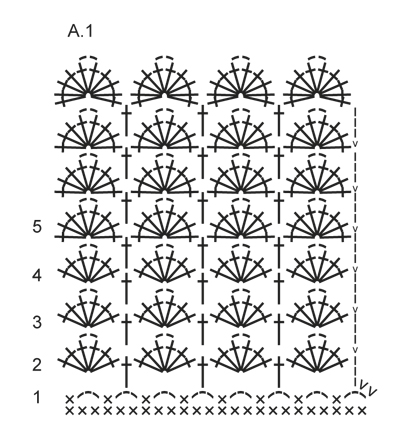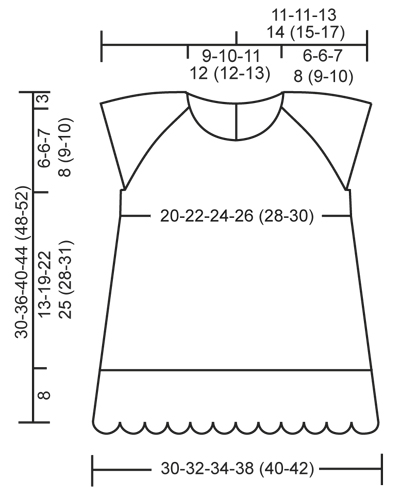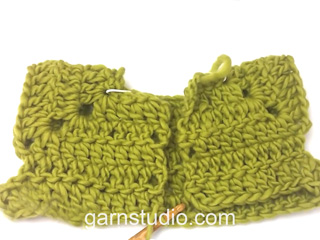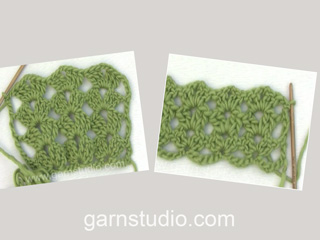Beth |
|||||||||||||
|
|
|||||||||||||
Crochet baby dress with raglan, short sleeves and fan edges, worked top down in DROPS BabyAlpaca Silk. Size 0-4 years
DROPS Baby 25-16 |
|||||||||||||
|
CROCHET INFO: Replace first dc at beg of every dc round/row with 1 ch. Finish round with 1 sl st in ch from beg of round. Finish row with 1 dc in 3rd ch from beg of previous row. Replace first tr at beg of every tr round/row with 3 ch. Finish round with 1 sl st in 3rd ch from beg of round. Finish row with 1 tr in ch from beg of previous row. TEXTURE ROWS: * 1 row/round dc, 1 row/round tr *, repeat from *-* (1 row/round dc + 1 row/round tr = 1 texture row). INCREASE TIP: Inc 1 dc/tr by working 2 dc/tr in same st. PATTERN: See diagram A.1. ---------------------------------------------------------- DRESS: The piece is worked top down. Work back and forth from mid back to after vent mid back, then work piece in the round. YOKE: Work 67-71-75-79 (79-83) ch (incl 1 ch to turn with) on hook size 3.5 mm with powder. Work 1 dc in 2nd ch from hook, then work 1 dc in every ch the entire row = 66-70-74-78 (78-82) dc on row. Now insert 4 markers in piece for raglan as follows (beg mid back – NOTE: Do NOT work while inserting markers): Skip 9-10-11-12 (12-13) dc (= right back piece), insert 1 marker in next dc, skip 13 dc (= sleeve), insert 1 marker in next dc, skip 18-20-22-24 (24-26) dc (= front piece), insert 1 marker in next dc, skip 13 dc (= sleeve) and insert last marker in next dc (there are now 9-10-11-12 (12-13) dc on left back piece after last marker). READ ALL OF THE FOLLOWING SECTION BEFORE CONTINUING: READ CROCHET INFO and work next row as follows from RS: Work 1 tr in every dc but in every dc with marker work 2 tr + 2 ch + 2 tr = 78-82-86-90 (90-94) tr on row. Then work TEXTURE ROWS – see explanation above (work back and forth with 1 dc/tr in every st from previous row but on every row with dc from WS work 2 ch over the 2 ch from previous row in raglan lines). AT THE SAME TIME on 1st row from RS (i.e. row with tr) inc for raglan as follows: Work 2 tr + 2 ch + 2 tr in every ch-space in every raglan line (= 16 tr inc on row - NOTE: Work in both ch-spaces). Repeat inc on every row from RS 3-3-4-4 (5-6) more times (= 4-4-5-5 (6-7) times in total) = 142-146-166-170 (186-206) sts. REMEMBER THE CROCHET TENSION! After last inc for raglan work 1 row with dc from WS as before. Work next row as follows from RS: Work 1 tr in each of the first 19-20-23-24 (26-29) dc (= right back piece), skip the next 33-33-37-37 (41-45) dc (= sleeve), work 6-8-6-10 (10-8) ch, work 1 tr in each of the next 38-40-46-48 (52-58) dc (= front piece), skip the next 33-33-37-37 (41-45) dc (= sleeve), work 6-8-6-10 (10-8) ch and work 1 tr in each of the last 19-20-23-24 (26-29) dc (= left back piece). Sleeve caps are now done and piece is worked in the round. BODY: Put piece tog mid back with RS out and work 1 round with dc (work 1 dc in every tr from previous round and 1 dc in every ch under each sleeve – remember CROCHET INFO) = 88-96-104-116 (124-132) sts on round. Insert 1 marker in each side = 44-48-52-58 (62-66) sts on front and back piece. Continue in the round with TEXTURE ROWS. When piece measures approx. 2 cm from markers under sleeves, inc 1 st on each side of both markers - READ INCREASE TIP (= 4 sts inc). Repeat inc every 1½-2-3-3 (3-3½) cm 5-6-6-7 (8-8) more times (= 6-7-7-8 (9-9) times in total) = 112-124-132-148 (160-168) sts. When piece measures approx. 13-19-22-25 (28-31) cm from markers (finish after 1 round with tr, inc should be done), work 1 round dc AT THE SAME TIME inc 8-2-0-2 (2-0) dc evenly – READ INCREASE TIP = 120-126-132-150 (162-168) dc. Cut the yarn. Switch to off white and work 1 round dc with 1 dc in every dc from previous round. Then work Fan pattern according to diagram A.1, i.e. work as follows: ROUND 1: * 3 ch, skip 2 dc, 1 dc in next dc *, repeat from *-* the entire round and finish with 3 ch and 1 sl st in 1st ch from beg of round = 40-42-44-50 (54-56) ch-spaces. ROUND 2: Work sl sts until mid of first ch-space, 3 ch (= 1 tr), * 3 tr + 2 ch + 3 tr in next ch-space, 1 tr in next ch-space *, repeat from *-* until 1 ch-space remains, work 3 tr + 2 ch + 3 tr in last ch-space and finish with 1 sl st in 3rd ch from beg of round = 20-21-22-25 (27-28) tr-groups with 1 tr between every tr-group. ROUND 3-4: 3 ch (= 1 tr), * 3 tr + 2 ch + 3 tr in ch-space in mid of next tr-group, 1 tr in next tr *, repeat from *-* the entire round, finish with 3 tr + 2 ch + 3 tr in ch-space in mid of last tr-group and 1 sl st in 3rd ch from beg of round. ROUND 5: Work as round 3-4 but in ch-space in the mid of every tr-group work 4 tr + 2 ch + 4 tr (instead of 3 tr + 2 ch + 3 tr). Repeat 5th round until edge measures approx. 6 cm in all sizes (or desired length). Then work last round the same way but with 5 tr + 2 ch + 5 tr in ch-space in the mid of every tr-group. TWINED STRING: Cut 3 lengths off white yarn of 3 metres each. Twine the strands tog until they resist, fold the string double so that it twines again. Make a knot at each end. Thread the string up and down through a tr row, approx. 2 cm below armhole on dress, beg from mid front. BOW: Work 11 ch on hook size 3.5 mm with off white. Work first row as follows: 1 tr in 4th ch from hook, 1 tr in each of the next 7 ch = 9 tr on row. Turn piece and work TEXTURE ROWS back and forth until piece measures approx. 10 cm – finish after 1 row with dc. Fasten off. Sew short sides tog to form a ring and twine some yarn around the mid of bow to tighten it neatly in the middle. Fasten bow mid front on dress, just above string. ADJUSTING NECKLINE: For better fit work a small elevation at the back of neck. Insert 1 marker in st in each corner in neck, i.e. at beg of every raglan line and 1 marker mid front. Work on hook size 3.5 mm with powder as follows: Beg mid back, work 1 dc in every st until 1 st remains before st with marker, work 1 htr in next st, 1 tr in st with marker and 1 htr in next st, then work 1 dc in every st until 1 st remains before next st with marker, 1 htr in next st, 1 tr in st with marker and 1 htr in next st, the work 1 dc in every st until 4-4-5-5 (5-6) sts remain before marker mid front. Turn piece and work 1 dc in every dc back to mid back but at every marker work 3 dc tog, i.e. work 1 dc in htr but wait with last YO and pull through, work 1 dc in st with marker but wait with last YO and pull through, work 1 dc in next htr but now pull last YO through all 4 sts on hook (= 2 dc dec). Cut the yarn and repeat from mid back to mid front in the other side. BUTTON BAND AT THE BACK: Work along left opening mid back with powder as follows: 1 dc in every dc row and 2 dc in every tr row. Work a total of 4 rows dc back and forth, fasten off. Along right opening mid back work buttonholes as follows (beg from RS at neckline): Work 3 dc (1 dc in dc row and 2 dc in tr row). 4 ch (= 1 buttonhole), skip approx. 1 cm, work dc until approx. mid on band, 4 ch, skip approx. 1 cm, work dc until 1 cm remains on band, 4 ch and fasten with 1 dc in last st. Fasten off. Sew the buttons on to button band in the left side. NECK EDGE: Work around the neck with off white as follows: 1 dc in first st, * 2 ch, skip 2 sts, 1 dc in next st *, repeat from *-* the entire row, fasten off. FAN EDGE AROUND SLEEVE CAPS: Work with off white as follows: Work 1 dc in each of the 6-8-6-10 (10-8) sts mid under sleeve, then work fan edge around the sleeve opening as follows: * Skip approx. 2 sts, in next st work 3 tr + 2 ch + 3 tr, skip approx. 2 sts, 1 dc in next st *, repeat from *-* and finish with 1 sl st in first dc from beg of round (= approx. 5-5-6-6 (7-7) fans along sleeve cap). Fasten off. Repeat at the bottom around the other sleeve cap. |
|||||||||||||
Diagram explanations |
|||||||||||||
|
|||||||||||||

|
|||||||||||||

|
|||||||||||||
|
Have you made this or any other of our designs? Tag your pictures in social media with #dropsdesign so we can see them! Do you need help with this pattern?You'll find tutorial videos, a Comments/Questions area and more by visiting the pattern on garnstudio.com. © 1982-2024 DROPS Design A/S. We reserve all rights. This document, including all its sub-sections, has copyrights. Read more about what you can do with our patterns at the bottom of each pattern on our site. |
|||||||||||||














































Comments / Questions (47)
Hur ska man göra i ökningarna på strukturvarvets fm-varv? Ska man virka 2fm+2lm+2fm?
25.10.2023 - 15:39DROPS Design answered:
Hej Fia, ÖKNINGSTIPS: Det ökas 1 fm/st genom att virka 2 fm/st i samma m.
26.10.2023 - 13:56Jeg hækler str. 6/9. Jeg har lige sat de fire mærketråde i. Jeg forstår simpelthen ikke HÆKLEINFO. Jeg skal til at hækle 1 st i hver fm, men hvis jeg starter med 3 lm som erstatter 1. st, så øger det jo antallet? F.eks: Starten af højre rygstykke har 11 lm. Når jeg er færdig med første række af stangmasker, så er der jo 12 masker der. Hvad er det jeg ikke forstår ved HÆKLEINFO??
20.05.2023 - 15:05DROPS Design answered:
Hej Maya, de 3 lm er til for at kommet en række op i højden. MEN se videoen vi har lavet til denne opskrift - du finder den nederst i opskriften :)
23.05.2023 - 11:10Hej! Jag skulle vilja veta om jag kan byta ut garnet till detta mönster till bomull? I kalkylatorn så kan den inte ge något förslag på annat garn. Hur mycket behöver jag isf och hur blir det med fastheten/nålen? Mvh nybörjaren
18.03.2021 - 08:30DROPS Design answered:
Hej Camilla, jo du får et forslag med DROPS Safran. Vælg BabyAlpaca Silk, vælg antal gram i din størrelse, vælg 1 tråd :)
18.03.2021 - 09:30Hej får inte ökningen vid raglanökningen att stämma Exempel minsta storlek;efter en ökning 2 st+2lm+2st har man 4 ggr har man enligt mönstret 78m.Hur är det möjligt ? Man hade 66 m och ökade 6 m 4 ggr vilket är 24 m Det stämmer inte. De andra fortsatta ökningarna stämmer inte heller. Mvh Margareta
10.12.2020 - 20:45DROPS Design answered:
Hej Margareta. Du ökar 3 st vid varje markör (istället för att virka 1 st så virkar du 2 st + 2 lm+ 2 st, dvs 3 st ökade). 3 st x 4 = 12 st ökade per varv. Mvh DROPS Design
11.12.2020 - 07:04Hi, question about the body section , are the markers at the front or the back ? I am a bit confused ! Many thanks in advance.
01.03.2020 - 00:59DROPS Design answered:
Dear Miriam, at the yoke the markers are at the 4 raglan-lone, and then, at the body there is 2 markers, 1 at each side of the dress. Happy Crafting!
01.03.2020 - 09:55Hei. :) Hvilket annet drops garn kan du anbefale å hekle denne kjolen i?
24.02.2020 - 17:24DROPS Design answered:
Hej Marte, Prøv vores garnkalkulator som findes under billedet i opskriften, så får du alle de kvaliteter fra garngruppe A som du kan erstatte DROPS BabyAlpaca med. God fornøjelse!
25.02.2020 - 08:51Hei. Jeg holder på å hekle kjolen, men når jeg skal hekle rundt. Da jeg har heklet rundt en omgang, skal jeg snu og hekle motsatt av neste omgang? Jeg har heklet samme vei ved hver omgang, men begynnelse og slutt blir skjev jo lenger jeg kommer nedover kjolen.
05.01.2020 - 23:08DROPS Design answered:
Hei MariAnne. Usikker på hva du gjør feil, men den skal ikke bli skeiv. Har du hoppet over noen masker når du snur? Prøv å telle maskene etter hver omgang. Husk å lese Hekleinfo i oppskriften. God Fornøyelse!
03.02.2020 - 14:24How many texture rows will there be in the yoke?
28.10.2019 - 22:45DROPS Design answered:
Hello Amy! It depends on the size. Please look at the number for your size. Happy crocheting!
30.10.2019 - 14:12Skal man tælle de 3 luftmasker i begyndelsen af omgangen med, når man skal kontrollere at man har 146 stangmasker, når man er færdig med udtagning til raglan?
26.02.2019 - 17:35DROPS Design answered:
Hei Charlotte. Første stav på omgangen erstattes av 3 luftmasker, så disse telles som 1 stav - se hekleinfo på toppen av oppskriften. God fornøyelse
07.03.2019 - 13:43Så jeg skal ikke tælle den første række med udtagninger med? Altså den med de 90 st?
07.12.2018 - 15:43DROPS Design answered:
Hei igjen Mette. Den første økingen der du øker til 90 staver er ikke medregnet i beskrivelsen av øking til raglan. Denne kommer i tillegg. Du øker altså først til 90 staver som beskrevet, og videre følger du økingen til raglan og øker slik totalt 6 ganger. Du har da 186 staver på omgangen. God fornøyelse.
10.12.2018 - 10:12